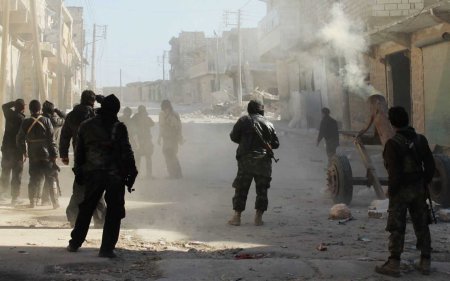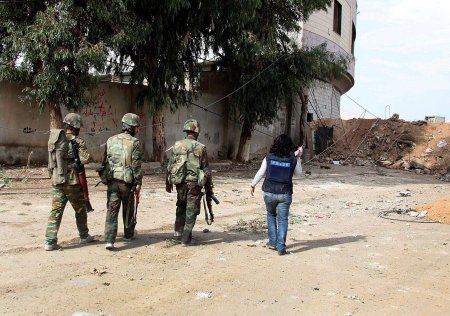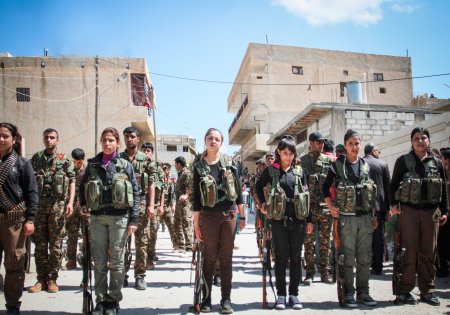Alaa Halabi As-Safir
The fighters of IS (Islamic State) have achieved a rapid and surprising advance in the countryside of northern Aleppo.
Several strategic villages fell to IS, which marked its territory in the village of Dabeq. IS also has its eye set on Azaz, its former stronghold. Meanwhile, the rebel factions fighting IS are shocked, while others have withdrawn and disappeared. The battles stopped at Marea city border, where the cards were being reshuffled amid speculation that a decisive and bloody battle would take place in the region — a battle that would also decide the fate of the rebel factions.
There have been many changes in the countryside of northern Aleppo which has been caused by the unexpected IS advances. The recent military gains of IS constitute an existential threat for the rebel factions fighting it and for the families of militants. Fear of massacres that might claim the lives of thousands of people has risen, especially in the face of IS massacres targeting the people from the Sheaitat tribe in the Deir ez-Zor countryside. As a result, a spirit of vengeance paired with desperation prevails over the organization’s battles, thus making yesterday’s foe a temporary friend.
In Marea city, which recently appeared as the most important stronghold for the armed rebel factions fighting IS, thousands of militants from Jaysh al-Islam, Jaysh al-Mujahedeen, Liwa al-Tawhid, Ahrar Souria, Noureddine al-Zinki and the Kurdish front have rallied, and members of the PKK (Kurdistan Workers’ Party) later joined them. The PKK fighters came from the Afreen region, which was besieged by the same rebel factions until recently.

Meanwhile, Jabhat al-Nusra, which was until now active around the region, just disappeared. An opposition source told As-Safir that the withdrawal of Jabhat al-Nusra, and the fact that public opinion turned against them, was one of the main changes in the region. He said that first the al-Nusra front did allow IS to take over Akhtarin. Then the al-Nusra fighters went back to Azaz and left the battlefronts. As a result, other forces had to replace them and intervene in the fighting, mainly the Kurdish groups who consider IS an enemy that threatens their existence in the region. New alliances were formed and the Kurds sent a large number of fighters, estimated at 2,000 men, who reached Marea and were deployed over the battle fronts.
Apart from Jabhat al-Nusra’s withdrawal and the public opinion’s change of heart in the northern countryside, the presence of Ahrar al-Sham, which is affiliated with al-Qaeda, also dwindled in the northern countryside of Aleppo — despite its former influence which rivaled al-Nusra’s. Ahrar al-Sham sent an insignificant number of militants and its leaders withdrew to the back lines. Meanwhile, small local rebel factions found themselves in the forefront. The same source considers this an important development in the region, which has been controlled mainly by these two radical groups for the last two years.
In the same context, a jihadist source said Ahrar al-Sham withdrew from their battles against IS because many militants refused to fight the “state’s jihadists,” i.e., IS soldiers, as this was something “forbidden” (haram).
As Jabhat al-Nusra and Ahrar al-Sham practically disappeared, the Syrian army gained momentum. It intensified its air raids on the hotbeds of IS militants. As a result, the organization’s pressure on the northern countryside decreased and its military offensive stopped. The opposition source said that the Syrian Air Force was launching daily raids against IS strongholds, and also against positions of Jabhat al-Nusra in Azaz and Ahrar al-Sham in Suran.

Alongside the Syrian army’s raids, which the rebel factions fighting IS consider a significant support, there is talk among the factions about several truces underway with the Syrian army on the nearby fronts. Those include withdrawing from the Handarat camp and partially lifting the siege on Nubl and Al-Zahraa to ensure complete dedication to fighting IS. However, the news has not been confirmed by any official source. Meanwhile, the facts on the ground indicate that the army wants a decisive military settlement by taking over the Bakara stretch and reaching the surroundings of the Canadian Hospital, as the military operations persist in Khan Touman, south of Aleppo.
Right now the battle fronts between IS and the rebel factions fighting it are eerily calm, with sporadic raids between both sides and clashes near Ehtemalat village. Each party has given its adversary 24 hours to withdraw.
In Aleppo, it seems that the road is paved for the Syrian army to advance to the eastern neighborhoods, with the rebel factions preoccupied by their war against IS and the fleeing of most civilians from the rebel controlled areas. This ought to affect the situation in and around Aleppo, although some signs indicate that the army does not want a bloody battle in the city and prefers to wait for settlements like they were reached in Homs. At the forefront is the settlement under consideration in the Sheikh Maqsoud neighborhood, which awaits the withdrawal of militants and its handover to Kurdish fighters of the YPD.

The fighters of IS (Islamic State) have achieved a rapid and surprising advance in the countryside of northern Aleppo.
Several strategic villages fell to IS, which marked its territory in the village of Dabeq. IS also has its eye set on Azaz, its former stronghold. Meanwhile, the rebel factions fighting IS are shocked, while others have withdrawn and disappeared. The battles stopped at Marea city border, where the cards were being reshuffled amid speculation that a decisive and bloody battle would take place in the region — a battle that would also decide the fate of the rebel factions.
There have been many changes in the countryside of northern Aleppo which has been caused by the unexpected IS advances. The recent military gains of IS constitute an existential threat for the rebel factions fighting it and for the families of militants. Fear of massacres that might claim the lives of thousands of people has risen, especially in the face of IS massacres targeting the people from the Sheaitat tribe in the Deir ez-Zor countryside. As a result, a spirit of vengeance paired with desperation prevails over the organization’s battles, thus making yesterday’s foe a temporary friend.
In Marea city, which recently appeared as the most important stronghold for the armed rebel factions fighting IS, thousands of militants from Jaysh al-Islam, Jaysh al-Mujahedeen, Liwa al-Tawhid, Ahrar Souria, Noureddine al-Zinki and the Kurdish front have rallied, and members of the PKK (Kurdistan Workers’ Party) later joined them. The PKK fighters came from the Afreen region, which was besieged by the same rebel factions until recently.

Meanwhile, Jabhat al-Nusra, which was until now active around the region, just disappeared. An opposition source told As-Safir that the withdrawal of Jabhat al-Nusra, and the fact that public opinion turned against them, was one of the main changes in the region. He said that first the al-Nusra front did allow IS to take over Akhtarin. Then the al-Nusra fighters went back to Azaz and left the battlefronts. As a result, other forces had to replace them and intervene in the fighting, mainly the Kurdish groups who consider IS an enemy that threatens their existence in the region. New alliances were formed and the Kurds sent a large number of fighters, estimated at 2,000 men, who reached Marea and were deployed over the battle fronts.
Apart from Jabhat al-Nusra’s withdrawal and the public opinion’s change of heart in the northern countryside, the presence of Ahrar al-Sham, which is affiliated with al-Qaeda, also dwindled in the northern countryside of Aleppo — despite its former influence which rivaled al-Nusra’s. Ahrar al-Sham sent an insignificant number of militants and its leaders withdrew to the back lines. Meanwhile, small local rebel factions found themselves in the forefront. The same source considers this an important development in the region, which has been controlled mainly by these two radical groups for the last two years.
In the same context, a jihadist source said Ahrar al-Sham withdrew from their battles against IS because many militants refused to fight the “state’s jihadists,” i.e., IS soldiers, as this was something “forbidden” (haram).
As Jabhat al-Nusra and Ahrar al-Sham practically disappeared, the Syrian army gained momentum. It intensified its air raids on the hotbeds of IS militants. As a result, the organization’s pressure on the northern countryside decreased and its military offensive stopped. The opposition source said that the Syrian Air Force was launching daily raids against IS strongholds, and also against positions of Jabhat al-Nusra in Azaz and Ahrar al-Sham in Suran.

Alongside the Syrian army’s raids, which the rebel factions fighting IS consider a significant support, there is talk among the factions about several truces underway with the Syrian army on the nearby fronts. Those include withdrawing from the Handarat camp and partially lifting the siege on Nubl and Al-Zahraa to ensure complete dedication to fighting IS. However, the news has not been confirmed by any official source. Meanwhile, the facts on the ground indicate that the army wants a decisive military settlement by taking over the Bakara stretch and reaching the surroundings of the Canadian Hospital, as the military operations persist in Khan Touman, south of Aleppo.
Right now the battle fronts between IS and the rebel factions fighting it are eerily calm, with sporadic raids between both sides and clashes near Ehtemalat village. Each party has given its adversary 24 hours to withdraw.
In Aleppo, it seems that the road is paved for the Syrian army to advance to the eastern neighborhoods, with the rebel factions preoccupied by their war against IS and the fleeing of most civilians from the rebel controlled areas. This ought to affect the situation in and around Aleppo, although some signs indicate that the army does not want a bloody battle in the city and prefers to wait for settlements like they were reached in Homs. At the forefront is the settlement under consideration in the Sheikh Maqsoud neighborhood, which awaits the withdrawal of militants and its handover to Kurdish fighters of the YPD.

Keine Kommentare:
Kommentar veröffentlichen